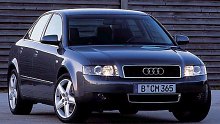 Undoubtedly,
the outgoing A4 changed the face of Audi. Impeccable build, pretty
appearance
and a refined 1.8T engine made it a commercial hit, washed out all the
unhappy memory of 80. However, no keen drivers ever praised its dynamic
ability - not only when facing BMW 3-seies but it was also badly beaten
by cheaper cars like Ford Mondeo and Peugeot 406. Under such
background,
Audi went back to drawing board and built an all-new A4 although the
current
car is only 5 years old. Undoubtedly,
the outgoing A4 changed the face of Audi. Impeccable build, pretty
appearance
and a refined 1.8T engine made it a commercial hit, washed out all the
unhappy memory of 80. However, no keen drivers ever praised its dynamic
ability - not only when facing BMW 3-seies but it was also badly beaten
by cheaper cars like Ford Mondeo and Peugeot 406. Under such
background,
Audi went back to drawing board and built an all-new A4 although the
current
car is only 5 years old.
Ingolstadt sorted out problems one by one scientifically. A 45% more rigid chassis is now equipped with all aluminium suspensions: the front is still the 4-link design but with revised geometry to kill squat and lift under acceleration and braking. Lower arms changed to alloy saved 8.5 kg of unsprung weight. At the rear, bye-bye the old half-independent torsion-beam which shared with Passat, now enter the aluminium trapezoidal multi-link suspension. Without doubt, the new suspensions’ lower unsprung weight allow a sportier spring and damping setup at no expense of ride quality. Moreover, they provide far better wheel control. Next problem to be solved is the notorious steering feel of the old car. By mounting the steering rack higher accompany with change of suspension geometry, the virtual steering axis becomes closer to the wheel center. The result is much more natural feel (also thanks to new pump valving in power steering) and eliminate torque steer, which could have been a problem for the more powerful V6. Yes, the new 3.0-litre V6 is another big improvement over the old 2.8 V6. The latter was not shame but compare with Mercedes’ 3.2 V6 and BMW’s 2.8 and 3.0 in-line six it was apparently unresponsive, less flexible and less smooth. Now the new V6 gains not only extra stroke but also an aluminium block (hence saving 17kg), lighter pistons (raise revability), infinite intake VVT, 2-stage exhaust VVT, 2-stage variable length intake manifolds and electronic throttle. Enough ? Besides, a balance shaft is employed to reduce first order vibration generated by the 90° V-angle which enable the V6 to be built in the same assembly line as V8s. The new engine is responsive and free-spinning from 2,000 upward to 6,800 rpm cut-out. Ultimately, at 220 horsepower it is not as powerful as BMW 330i but it is no less attractive to ears - a thing rarely found in an Audi engine. From 4,400 rpm, the resonance box produces a purposeful snarl matching the Munich rival. Speaking of real talent, Audi claims it can propel the front-wheel-drive and manual transmission car to 60 mph in 6.6 sec, that is the same league of the fire-breathing 330i and a second quicker than the automatic-only C320. The entry-level 2.0-litre 20-valve four employs similar technology - all-alloy, continuous VVT at intake (but no VVT at exhaust side), 2-stage intake manifold and twin balance shaft. That sounds impressive. More impressive is that it is claimed to be the lightest one in its class, at 129kg. Nevertheless, that’s just a waste of good material because it is unwilling to spin at high rev thus generates quite a lot of NVH. It seems that the very long stroke design of combustion chamber (82.5 mm bore versus 92.8 mm stroke) account for the unrefined manner despite of the help of balance shafts. In terms of output, I am disappointed with its 130 hp which is by far lower than class standard but the peak torque of 144 lbft at 3500 rpm is impressive. However, I would have preferred more power and refinement in the price of a little bit torque. Ford Mondeo seems cleverer. The engine range also consists of the existing 150 hp 1.8 turbo, a 130 hp pump injection turbo diesel 1.9 and a 2.5 TDI V6 turbo diesel outputting a strong 180 hp. The 1.8T still withstand the test of time well but now it has to pull an extra 30-50 kg thus you can’t expect the same performance as before. Last bug to be fixed was gearbox. Multitronic CVT is world famous, but the old 5-speed manual used to receive a lot of criticism about its rubbery shift quality. Now a new shift mechanism provides slick gear shift accompany with a smoother clutch actuation. On The Road
Performance and eagerness of the V6 is awesome, but what road testers really want to find out is whether the chassis can beat its arch rivals. Turn the steering wheel and you’ll immediately realise this is a revelation - meaty weighting, just the right amount of self-centering, sharp, precise, uncorrupted feedback ... this is probably the best front-drive steering, no, it is so much more lovely than the rear-drive 3-series and matches the high achievement of C-class. Ride is quite firm, so body control is fluent and composed. It feels like a new Mondeo with 10% more in every aspect - grip, understeering resistance, stability and agility. Admittedly, the same description can also be applied to C-class and to lesser extent the BMW. Now we can forget the B because it is quite obviously out of competitiveness against the C and A. The real question is: C or A better ? While both display the same competent dynamic, the C-class is specially honored for providing supple ride simultaneously. In contrast, the new A4 achieve good handling partially in the price of ride quality, which is firm although far from uncomfortable. It is just that the C-class rides too well, unreasonably well. We heard BMW is now retuning the steering and suspension of the 3-series - and the result is likely to change the whole picture - but this is not considered here. Let us praise Jos
Van As
for tuning such a fabulous chassis. Having tuned the current 3-series,
the Dutchman left BMW in 1997 and joined Audi as manager of vehicle
dynamics,
reponsible for tuning A2 and then A4, no wonder the A4 improves so
much.
I am now eagerly awaiting a new S4 to come ... |
| The above report was last updated on 27 Mar 2001. All Rights Reserved. |
 The
new styling is not as radical as I thought. To certain extent it is
even
conservative by Audi’s standard - a standard set by the TT Coupe, A6
and
A2. However, it is undeniable that it feels elegant and expensive. Shut
lines are narrow, paint work done perfectly, best fit and finish of
cabin
you can find in the mass production industry. The interior is not as
large
as C-class but rear passenger room beats the 3-series. Compare with old
A4 the wheelbase has been stretched by 33 mm. No wonder rear passenger
gets 41 mm extra knee room and 29 mm more elbow room. Of course, none
of
these cars can match the cheaper new Mondeo. Build quality wise, none
of
them are comparable with the A4.
The
new styling is not as radical as I thought. To certain extent it is
even
conservative by Audi’s standard - a standard set by the TT Coupe, A6
and
A2. However, it is undeniable that it feels elegant and expensive. Shut
lines are narrow, paint work done perfectly, best fit and finish of
cabin
you can find in the mass production industry. The interior is not as
large
as C-class but rear passenger room beats the 3-series. Compare with old
A4 the wheelbase has been stretched by 33 mm. No wonder rear passenger
gets 41 mm extra knee room and 29 mm more elbow room. Of course, none
of
these cars can match the cheaper new Mondeo. Build quality wise, none
of
them are comparable with the A4. 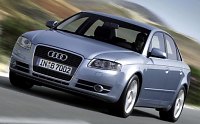 The
A4 received a facelift in late 2004. Both the nose and
the tail were completely restyled. Most obvious is the "single-frame
grille" resembling the A6's, which looks very imposing.
The
A4 received a facelift in late 2004. Both the nose and
the tail were completely restyled. Most obvious is the "single-frame
grille" resembling the A6's, which looks very imposing.  In the
mechanical side, the facelift brings a revised
suspension setup and the latest engines. The suspension mod includes
revised
springing and damping, and the use of S4's rear trapezoidal links, rear
wheel
carriers and front track rods. These modifications improved ride
quality a bit.
In the
mechanical side, the facelift brings a revised
suspension setup and the latest engines. The suspension mod includes
revised
springing and damping, and the use of S4's rear trapezoidal links, rear
wheel
carriers and front track rods. These modifications improved ride
quality a bit.  Some
history: in 1985, Audi launched a small sedan called 80. Although this
car was superceded by the first A4 in 1996, its coupe and cabriolet
version
were never updated to the new A4 format. The cabriolet, called Coupe
Cabriolet,
was especially time-enduring. From 1991 to 2000 its life spanned across
a whole decade and still looked handsome by today’s standard, thanks to
its clean styling theme and elegant details.
Some
history: in 1985, Audi launched a small sedan called 80. Although this
car was superceded by the first A4 in 1996, its coupe and cabriolet
version
were never updated to the new A4 format. The cabriolet, called Coupe
Cabriolet,
was especially time-enduring. From 1991 to 2000 its life spanned across
a whole decade and still looked handsome by today’s standard, thanks to
its clean styling theme and elegant details.
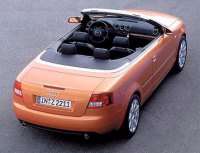 The
Karmann electric hood opens and closes in 24 seconds. 3 layers keep the
cabin free of wind noise. The dashboard looks quite different from the
sedan, thanks to 5 circular air vents with chromed surrounds. Rear
legroom
is good by convertible standard. In short, this is a high-quality and
comfortable
place to spend your weekends.
The
Karmann electric hood opens and closes in 24 seconds. 3 layers keep the
cabin free of wind noise. The dashboard looks quite different from the
sedan, thanks to 5 circular air vents with chromed surrounds. Rear
legroom
is good by convertible standard. In short, this is a high-quality and
comfortable
place to spend your weekends. 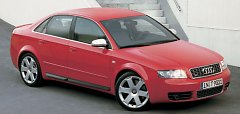 The
old S4 was regarded as a bad example of German performance sedan - fast
but unengaging. Worst of all, it lived under the shadow of BMW’s E36
M3.
However, Audi has changed a lot since then. Today’s A4 is a very good
car,
nearly matches 3-series for driver appeal. Build on this basis, if
Ingostadt
do it right, the new S4 has any right to beat the M3, especially it was
able to use the M3 as benchmark during development.
The
old S4 was regarded as a bad example of German performance sedan - fast
but unengaging. Worst of all, it lived under the shadow of BMW’s E36
M3.
However, Audi has changed a lot since then. Today’s A4 is a very good
car,
nearly matches 3-series for driver appeal. Build on this basis, if
Ingostadt
do it right, the new S4 has any right to beat the M3, especially it was
able to use the M3 as benchmark during development.
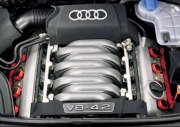 The
big V8 barely fits into the engine bay. In fact, engineers had to
redesign
its peripheral gear chains to make it short enough. As usual, Audi
constructed
it entirely in aluminum alloy, except the intake manifolds, which are
even
lighter magnesium alloy. At 195kg, it is no heavier than the old
twin-turbo
V6. This engine has 5 valve per cylinder, 2-stage variable intake
manifolds
and a variable valve timing at the intake side. Compare with A8’s, its
tuning biases towards power rather than torque. Lightened pistons and
con-rods
allow it to spin to 7200rpm, outstanding for a long-stroke engine. At
7,000rpm,
it pumps out the maximum 344 horsepower - exactly one horsepower more
than
M3, is it just a coincidence?
The
big V8 barely fits into the engine bay. In fact, engineers had to
redesign
its peripheral gear chains to make it short enough. As usual, Audi
constructed
it entirely in aluminum alloy, except the intake manifolds, which are
even
lighter magnesium alloy. At 195kg, it is no heavier than the old
twin-turbo
V6. This engine has 5 valve per cylinder, 2-stage variable intake
manifolds
and a variable valve timing at the intake side. Compare with A8’s, its
tuning biases towards power rather than torque. Lightened pistons and
con-rods
allow it to spin to 7200rpm, outstanding for a long-stroke engine. At
7,000rpm,
it pumps out the maximum 344 horsepower - exactly one horsepower more
than
M3, is it just a coincidence?  Enter
country roads and the disadvantage of S4 becomes clearer. On the one
hand,
it rides firmly or even uncomfortably on less-than-smooth surfaces,
implying
the suspensions are set too hard. On the other hand, strangely, body
control
is not as good as expected. There are more pitch and roll than the M3,
or a HSV Commodore. Although the steering is quick, the car doesn’t
turn-in
as agile as its Munich rival. Our conclusion: it needs a better
balanced
chassis to challenge BMW.
Enter
country roads and the disadvantage of S4 becomes clearer. On the one
hand,
it rides firmly or even uncomfortably on less-than-smooth surfaces,
implying
the suspensions are set too hard. On the other hand, strangely, body
control
is not as good as expected. There are more pitch and roll than the M3,
or a HSV Commodore. Although the steering is quick, the car doesn’t
turn-in
as agile as its Munich rival. Our conclusion: it needs a better
balanced
chassis to challenge BMW.  The
desire
to beat BMW is increasingly strong at Ingolstadt. Audi no longer
wants to live under the shadow of BMW. It wants to get recognition from the
world that the four-ring logo represents the
"ultimate driving machines". That's why in 1994 it
established the RS line above the S line. Depending on your
understanding, the "R" in its name might stand for
"Racing", "Rare" or "Riches". They are
considerably more expensive than BMW M3 and are produced at a much
slower rate. They employed high-pressure turbochargers to produce big
power, Quattro system to ensure all power is effectively transformed
to motion, very stiff suspensions keep cornering flat and huge brakes
to stop the car in an instant. The first RS car was RS2, a 315 hp
version of the contemporary S2 Avant developed and produced with the
help of Porsche. In 2000, the S4 Avant-based RS4 upped the game to
380 horsepower with a twin-turbo V6. Both cars were more powerful
than the contemporary BMW M3 and did 0-60 mph in no more than 4.8
seconds.
The
desire
to beat BMW is increasingly strong at Ingolstadt. Audi no longer
wants to live under the shadow of BMW. It wants to get recognition from the
world that the four-ring logo represents the
"ultimate driving machines". That's why in 1994 it
established the RS line above the S line. Depending on your
understanding, the "R" in its name might stand for
"Racing", "Rare" or "Riches". They are
considerably more expensive than BMW M3 and are produced at a much
slower rate. They employed high-pressure turbochargers to produce big
power, Quattro system to ensure all power is effectively transformed
to motion, very stiff suspensions keep cornering flat and huge brakes
to stop the car in an instant. The first RS car was RS2, a 315 hp
version of the contemporary S2 Avant developed and produced with the
help of Porsche. In 2000, the S4 Avant-based RS4 upped the game to
380 horsepower with a twin-turbo V6. Both cars were more powerful
than the contemporary BMW M3 and did 0-60 mph in no more than 4.8
seconds.  Nevertheless,
in the view of motoring writers, both RS2 and RS4 failed to beat M3.
Why? one of the reasons is the engine. Although Audi's high-pressure
turbocharged engines are powerful, they lack the eager, responsive
and silky smooth manner of BMW's high-revving normally aspirated
straight-6. That's why in the latest RS4 Audi finally gave up
turbocharging and adopted a high-revving normally aspirated V8. The
4163 cc V8 is derived from the S4. In the latter state of tune it
already produces 1 more horsepower than BMW M3. For transplanting
into RS4, a surgery replaced all pistons, con-rods and crankshaft
with lighter, stronger and lower friction ones to enable a sky-high
8250 rpm redline. Enlarged exhaust system reduces back pressure to
the combustion chambers. New cylinder heads switched from 5 to 4 valves
per cylinder, then added FSI direct
injection. Inject fuel spray directly
into the combustion chambers help cooling the latter, thus allows a
higher compression ratio at 12.5:1. (For your reference, BMW M3 is
11.5:1) This improves thermal efficiency significantly and
contributes to a specific output of 100 horsepower per litre ! at
7800 rpm, the fast-spinning V8 produces 420 horsepower, enough to
keep it save from the next generation BMW M3 (expect to be in the
region of 400-410 hp from its 4-litre V8). This engine is also very
torquey, with a total of 317 lbft at 5500 rpm and at least 90% of
which from 2250-7600 rpm. Compare with it, the current M3's
straight-6 is far more peaky, while delivering 77 fewer horses and 48
fewer pound-foot.
Nevertheless,
in the view of motoring writers, both RS2 and RS4 failed to beat M3.
Why? one of the reasons is the engine. Although Audi's high-pressure
turbocharged engines are powerful, they lack the eager, responsive
and silky smooth manner of BMW's high-revving normally aspirated
straight-6. That's why in the latest RS4 Audi finally gave up
turbocharging and adopted a high-revving normally aspirated V8. The
4163 cc V8 is derived from the S4. In the latter state of tune it
already produces 1 more horsepower than BMW M3. For transplanting
into RS4, a surgery replaced all pistons, con-rods and crankshaft
with lighter, stronger and lower friction ones to enable a sky-high
8250 rpm redline. Enlarged exhaust system reduces back pressure to
the combustion chambers. New cylinder heads switched from 5 to 4 valves
per cylinder, then added FSI direct
injection. Inject fuel spray directly
into the combustion chambers help cooling the latter, thus allows a
higher compression ratio at 12.5:1. (For your reference, BMW M3 is
11.5:1) This improves thermal efficiency significantly and
contributes to a specific output of 100 horsepower per litre ! at
7800 rpm, the fast-spinning V8 produces 420 horsepower, enough to
keep it save from the next generation BMW M3 (expect to be in the
region of 400-410 hp from its 4-litre V8). This engine is also very
torquey, with a total of 317 lbft at 5500 rpm and at least 90% of
which from 2250-7600 rpm. Compare with it, the current M3's
straight-6 is far more peaky, while delivering 77 fewer horses and 48
fewer pound-foot.  The huge
brakes, measuring 365 mm and 324 mm diameter front and rear
respectively, are similarly impressive. They provide reassuring
stopping power as well as superb pedal feel.
The huge
brakes, measuring 365 mm and 324 mm diameter front and rear
respectively, are similarly impressive. They provide reassuring
stopping power as well as superb pedal feel.  But
handling is not all about lap time. Instead, balance, controllability
and communication are usually more crucial. In this aspect, the RS4
has taken a major leap from its predecessor as well as S4 but still
lags behind its Munich rival. Yes, the Dynamic Ride Control adaptive
damping keeps its body motion to minimal. Through bends, the RS4 runs
flatly and, in addition to the tremendous traction, gives its driver
full confidence. The rear-biased new Quattro system also reduces
understeer considerably and lightens the steering to give more feel.
However, you can still feel the mass at the nose - although DRC
suppresses nose dive successfully, you can feel the RS4 respond to
steering without the enthusiasm of M3. The Munich rival feels sharper
and more nimble in the twisties. When the driver want to power slide,
he knows the active differential-equipped BMW is the one he want. How
clever the new Quattro system is, it is still a passive device. Maybe
Audi should think about Mitsubishi Evo-style active center
differential and active yaw control in the next generation RS cars.
But
handling is not all about lap time. Instead, balance, controllability
and communication are usually more crucial. In this aspect, the RS4
has taken a major leap from its predecessor as well as S4 but still
lags behind its Munich rival. Yes, the Dynamic Ride Control adaptive
damping keeps its body motion to minimal. Through bends, the RS4 runs
flatly and, in addition to the tremendous traction, gives its driver
full confidence. The rear-biased new Quattro system also reduces
understeer considerably and lightens the steering to give more feel.
However, you can still feel the mass at the nose - although DRC
suppresses nose dive successfully, you can feel the RS4 respond to
steering without the enthusiasm of M3. The Munich rival feels sharper
and more nimble in the twisties. When the driver want to power slide,
he knows the active differential-equipped BMW is the one he want. How
clever the new Quattro system is, it is still a passive device. Maybe
Audi should think about Mitsubishi Evo-style active center
differential and active yaw control in the next generation RS cars.